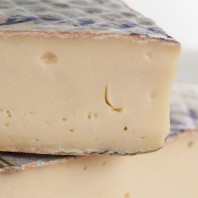 | Our Pic |
Saint Nectaire |

Country: France
Cheese Texture/Type: Semi-Soft
Cheese Milk Type: Cow
Cheese Age: 2-3 months
|
|
|
While many cheeses have fruity essences, there aren't many with a flavor profile that is dominated by fruit flavors. St. Nectaire (meaning sweet nectar) has a similar smell to that of an extremely ripe nectarine, although the names are not related. The cheese has a fruity aroma, rich texture, and a sweet flavor that we have yet to discover in any other cheese. You're certain to enjoy this unique, fruity delight!
St. Nectaire has been produced in the region of Monts-Dore in northern Auvergne for centuries. Monts-Dore is known as "montagres à vaches," or "mountains for cows," as they provide summer pasture for herds raised primarily for milk and the production of cheese. Its reputation as a cow-grazing homestead has made its way into French consciousness because many cheeses come from this famed region in the geographical heart of France. In the winter the land is covered with deep snow and when summer arrives it brings very high temperatures. Although this may sound punishing, the weather is actually ideal for both wine and cheesemaking.
St. Nectaire is made from the milk of Salers (pronounced sal'air) cows, which have played a critical role in cheesemaking for hundreds of years. Salers cows were named after a village from the Middle Ages, situated in the heart of the mountains. They are a visually intriguing reddish-brown color and possess angled, lyre-shaped horns. The flavor of their famed milk is a result of both genetics and the rich, perfumed volcanic pastures they enjoy from April to October. These volcanic meadows are loaded with phosphorus, potassium, and magnesium, all of which are found in high concentrations in the Salers' milk, and all of which are integral to the final flavor of St. Nectaire cheese.
St. Nectaire, like the Salers cows from which it comes, also has an interesting color. Its grayish-purple rind is covered with white, yellow, and red mold spots, a result of the wild grasses that the Salers cows eat during summer and autumn. A whole cheese is only about eight inches in diameter and weighs about four pounds. If you love a creamy, milky cheese, you’re going to love St. Nectaire. It goes extremely well with fruits, raw vegetables, olives, bread, and salami.
The St. Nectaire you are enjoying is as authentic and genuine as a cheese can be. This is assured by the fact that it is an A.O.C. cheese. In Europe, traditional food is a serious business, one that governments are committed to protecting. France was the first country to initiate this type of regulation. On May 6, 1919, it passed the first law for the Protection of the Place of Origin (A.O.C. or Appellation d'Origine Controlee). This law specifically defines the place of origin for a product, including province, region, and commune. Italy and Spain have since followed suit. You will most commonly see these designations on cheeses from these three European countries.
|
| Tasting Notes: |
|
A full-tasting cheese, slightly acidic and spicy at the same time, St. Nectaire’s supple white dough melts in your mouth and unleashes subtle notes of salt, walnuts, and spices. The texture is semi-soft with small eyes in the paste. The flavor is a wonderful combination of a summer pasture and sweet, fruity milk and it has an unmistakable smell of dark, damp cellar and rye straw, on which it is stored during the ripening process. St. Nectaire is an excellent choice for a cheese board, and makes an outstanding quiche. It goes extremely well with fruits, raw vegetables, olives, bread, and salami. For a fantastic combination, serve St. Nectaire on buttered bread with a steaming bowl of soup. Dip the bread and cheese in the soup and enjoy!
| |
|
03/17/2015
|
|